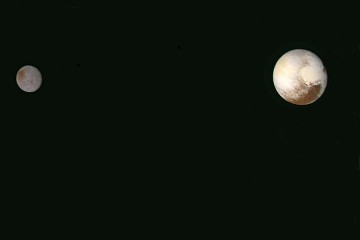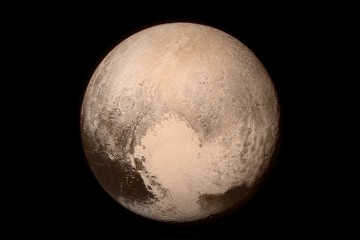The spacecraft New Horizons sped past Pluto and its moons on July 14, 2015, gathering data from seven onboard instruments. Shortly thereafter, it began offloading that data in a stream of digital bits that eventually stretched through space for more than 3 billion miles, a filament of zeros and ones that grew ever longer as the spacecraft voyaged farther and farther from Earth. In late October, the last of the data gathered during the flyby reached Earth, and mission scientists from the Applied Physics Laboratory and the Southwest Research Institute have begun to draw some conclusions.
When New Horizons launched in 2006, no one knew what to expect. But one distinct possibility was that Pluto would turn out to be a cold, dead, battered ball of rock, pocked with craters, geologically inert, and not much changed in the last 4 billion years. "The people who were on the frontier of modeling the formation of planets were saying it was going to be very boring. We might not see anything," says APL's Hal Weaver, the New Horizons project scientist. But as soon as they glimpsed the first detailed images from the spacecraft, scientists realized Pluto was far more interesting than they had ever imagined—a remarkably varied and complex world. Already at the first post-flyby press conference, the researchers were giddy, and not just because most of them had gone 36 hours without much sleep.
The first batch of scientific papers has appeared in research journals, and a summary of the most striking findings hints at how odd and wonderful Pluto and its moons have turned out to be, and what a fantastic little spacecraft New Horizons has been. Once the scientists are sure there are no gaps in the data, that every last byte has been collected, they will begin erasing New Horizons' hard drives to make room for data from the next flyby destination two years hence: a Kuiper Belt object known only as 2014 MU69. Want to know all about it? Check back on New Year's Day 2019.
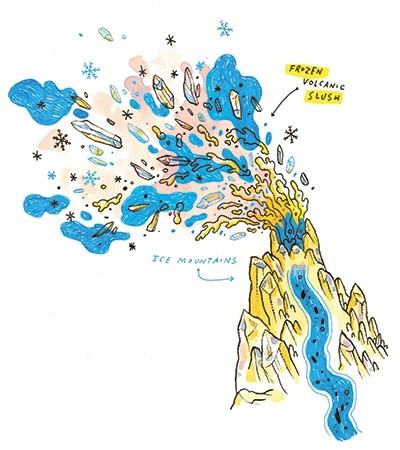
Image credit: Illustrations by John Hendrix
Icy volatility
In scientific parlance, a volatile is a substance that readily vaporizes. The term shows up over and over again in the first papers published by New Horizons mission scientists because volatiles turn out to be abundant on Pluto, frozen both on the surface of the dwarf planet and in a thin blue atmosphere above it.
When Pluto is in the portion of its elliptical 248-year orbit that is nearest the sun, some of that frozen gas thaws and sublimates into the atmosphere; when Pluto enters the cold part of its orbit, farthest from the sun, part of the atmosphere condenses and falls back to the surface. These cycles can also take place on a weekly time scale.
A substantial area, shaped like a massive heart and provisionally named the Tombaugh Regio, features a western lobe covered in mostly nitrogen snow and an eastern lobe coated by mostly methane ice. Elsewhere on the hemisphere scanned by New Horizons are frozen carbon monoxide, methane, ethane, nitrogen, and water. Charon, the largest moon, has water ice with some frozen ammonia. On Pluto, the nitrogen ice behaves much like water ice on Earth; for example, it can flow like terrestrial glaciers, from highlands down to lowlands and around barriers.
These volatiles do not exist only as icy plains. Pluto has mountains composed of water ice so cold it more resembles rock than the stuff of ice cubes. The photos show them: massive blocks of ice, kilometers across and embedded in seas of frozen nitrogen or carbon monoxide that may have carried them along like icebergs. Frozen water is more buoyant than frozen nitrogen, so if some of the nitrogen ice is deep enough, the ice mountains might be floating in it. Think of that—floating ice mountains.
One of these peaks, Piccard Mons, is more than 19,500 feet high. Another, Wright Mons, is more than 14,000 feet in height and 90 miles across. What's more striking than their size is that both show evidence of being ice volcanoes, previously encountered only on Triton, the largest moon of Neptune. If that is indeed what they are, were they to erupt, they would not spew lava. They would spew something closer to slush.
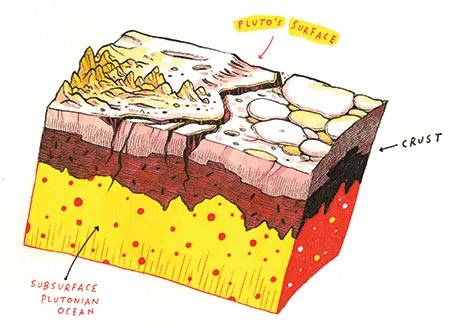
Image credit: Illustrations by John Hendrix
Not so dead, not so bland
Planetary scientists expected Pluto to be cold to its core, geologically unchanged for 4 billion years. Instead, New Horizons found ample evidence of an active geology, despite the absence of a molten core like the one that continually alters Earth through volcanism and tectonic shift. New Horizons principal investigator Alan Stern, of Southwest Research Institute, was stunned by the variety of surface features on Pluto—craters, for sure, but also those ice mountains, and vast plains, and bladed ridges, and canyons. Stern has said, "I don't know any other place in the entirety of the outer solar system where you see anything like this. The closest analogy is Earth, where we see water-rich surfaces and rock-rich surfaces that are completely different."
The driver of geologic change is heat. Where would that heat come from on a world too small to have a hot core like Earth's? No one knows, at least not yet, but Stern has an idea: a subsurface Plutonian ocean of water and ammonia that releases latent heat as it freezes. (A liquid contains more energy than a solid. As a liquid freezes—becomes a solid—this energy is released as heat.) Photos from New Horizons show evidence of the planet's crust stretching and breaking apart, an indication of the slow freezing of a subsurface ocean. Had Pluto's ocean frozen completely, there would be evidence of shrinkage from the formation of a dense type of ice called ice II; the lack of any sign of this activity leads Stern to speculate that liquid water is still there below Pluto's crust.
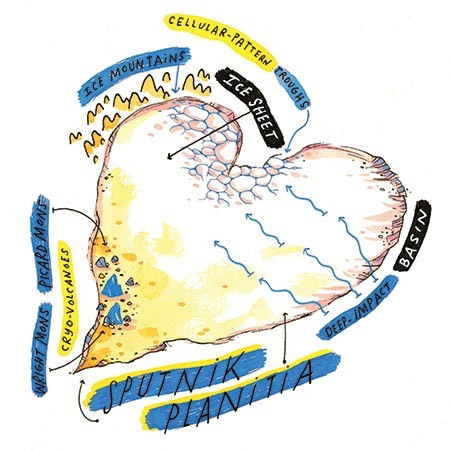
Image credit: Illustrations by John Hendrix
Sputnik Planitia
One of the leading indicators of an active geology is the western lobe of Tombaugh Regio, an area that scientists have dubbed Sputnik Planitia. Much of it appears to be an ice sheet, free of craters, that is probably less than 10 million years old, young in solar system terms. One indication that the plain is made of ice is the presence of "bubbles" that could have been formed by convection cells. Weaver likens convection cells to a lava lamp: "You get heating from below, and stuff flows up, and then it cools and comes back down." The northwestern edge also has those water ice mountains, and to the south are the possible cryovolcanoes, Wright Mons and Piccard Mons.
Sputnik Planitia's ice rests in a 2-mile-deep basin that may be the oldest and largest remaining impact crater on Pluto's surface. Where did all the ice come from? One thought: nitrogen glaciers that flow onto the surface during Pluto's winter. There is some evidence that this ice might be exceptionally soft. Central and northern regions of Sputnik Planitia also display some sort of polygonal pattern, as yet unexplained. In the central portion, troughs up to 100 meters deep bind the cells, like moats.
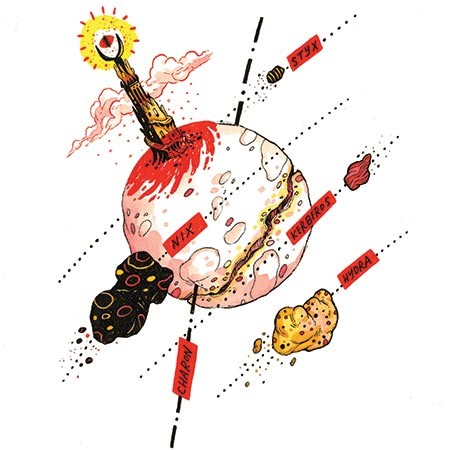
Image credit: Illustrations by John Hendrix
Charon et al.
Charon and two of its four sibling moons—Hydra and Nix—appear to be the same age, lending credence to the theory that the planetary system formed when something massive collided with Pluto, creating a debris cloud that eventually accreted first into a disk, then into the system of moons. Charon is so big relative to Pluto that scientists consider the two to be a binary planetary system.
Unlike Pluto, Charon appears to be geologically dead, but it has no end of interesting features. One is a massive canyon, a 600-mile equatorial gash that may have formed when a subsurface ocean of water froze and expanded, eventually rupturing the moon's surface and extending it. Says Weaver, "I think Charon basically broke apart at the seams."
Another striking feature, detected in the first detailed images, is a red polar region covered in complex hydrocarbons called tholins. How did the tholins get there? Scientists speculate that some of Pluto's methane atmosphere wisps away from the planet during Pluto's summer and lands on Charon. This methane then freezes out in the satellite's coldest polar regions. Over time, bombardment of this ice by ultraviolet light, cosmic rays, and solar wind converts it to the dark red tholins.
Someone on the New Horizons team appears to be a fan of J.R.R. Tolkien—the red feature has been provisionally named Mordor Macula.
Posted in Science+Technology
Tagged astronomy, applied physics laboratory, new horizons, pluto






